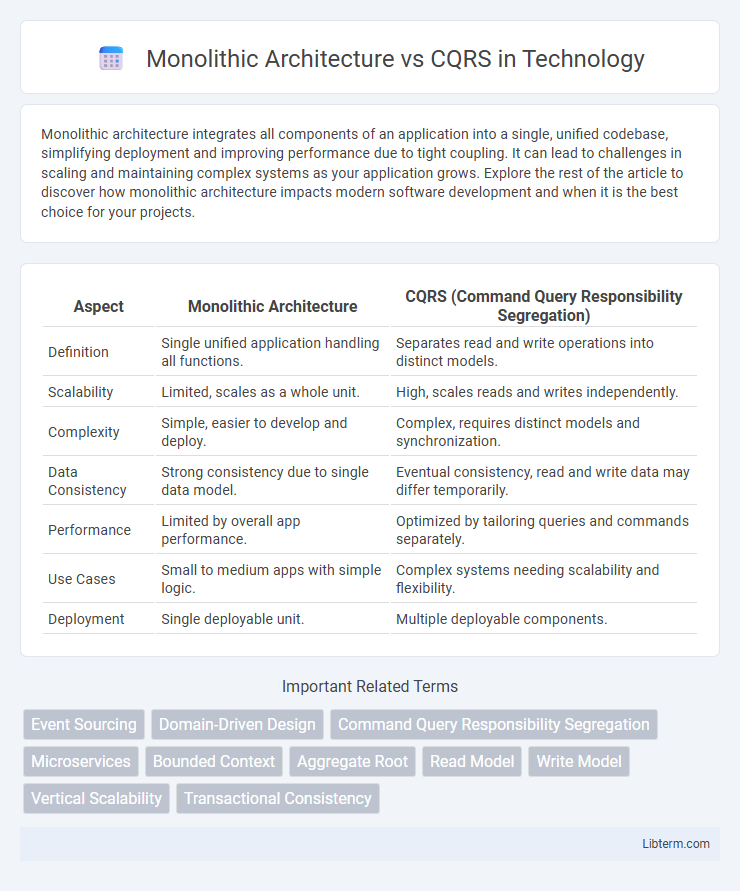Monolithic architecture integrates all components of an application into a single, unified codebase, simplifying deployment and improving performance due to tight coupling. It can lead to challenges in scaling and maintaining complex systems as your application grows. Explore the rest of the article to discover how monolithic architecture impacts modern software development and when it is the best choice for your projects.
Table of Comparison
| Aspect | Monolithic Architecture | CQRS (Command Query Responsibility Segregation) |
|---|---|---|
| Definition | Single unified application handling all functions. | Separates read and write operations into distinct models. |
| Scalability | Limited, scales as a whole unit. | High, scales reads and writes independently. |
| Complexity | Simple, easier to develop and deploy. | Complex, requires distinct models and synchronization. |
| Data Consistency | Strong consistency due to single data model. | Eventual consistency, read and write data may differ temporarily. |
| Performance | Limited by overall app performance. | Optimized by tailoring queries and commands separately. |
| Use Cases | Small to medium apps with simple logic. | Complex systems needing scalability and flexibility. |
| Deployment | Single deployable unit. | Multiple deployable components. |
Introduction to Monolithic Architecture and CQRS
Monolithic architecture consolidates all application components and services into a single, unified codebase, enabling straightforward deployment but potentially hindering scalability and maintainability. CQRS (Command Query Responsibility Segregation) separates data modification commands from read queries, optimizing performance and scalability by allowing independent scaling and specialized handling of each operation. Understanding these foundational architectures helps in selecting appropriate design patterns for complex, high-demand systems.
Core Concepts of Monolithic Architecture
Monolithic architecture consolidates all components of an application into a single, unified codebase, enabling straightforward deployment and tight integration of features. It relies on a shared database and monolithic service, which can simplify development but may introduce scalability and maintenance challenges as the application grows. Core concepts include a single executable, centralized data management, and synchronous communication between tightly coupled modules.
Core Principles of CQRS (Command Query Responsibility Segregation)
CQRS (Command Query Responsibility Segregation) is a design pattern that distinctly separates the read and write operations of a system, optimizing each for scalability and performance. Core principles include the segregation of commands, which modify state, from queries, which retrieve data without side effects, enabling independent models for updating and reading. This separation enhances maintainability, supports complex domain logic, and facilitates eventual consistency in distributed systems compared to traditional monolithic architectures.
Key Differences Between Monolithic and CQRS Architectures
Monolithic architecture consolidates all components and services into a single, unified codebase, leading to simpler deployment but limited scalability and flexibility. CQRS (Command Query Responsibility Segregation) separates read and write operations into distinct models, enhancing scalability, performance, and maintainability by optimizing each for its specific task. Key differences include monolithic systems' rigid structure versus CQRS's modularity, monolithic's combined data handling versus CQRS's distinct read/write data stores, and monolithic's slower adaptation to changing business requirements compared to CQRS's agility in evolving complex domains.
Pros and Cons of Monolithic Architecture
Monolithic architecture centralizes all components of an application into a single codebase, simplifying development and deployment but often leading to scalability challenges and slower release cycles. Its unified design facilitates easier debugging and testing, yet the tightly coupled modules can cause maintenance difficulties as the application grows. Performance bottlenecks and limited flexibility in technology stacks are common drawbacks compared to distributed patterns like CQRS.
Pros and Cons of CQRS Architecture
CQRS architecture separates read and write operations, enhancing scalability and performance by optimizing each side independently, ideal for complex domains requiring clear segregation of concerns. It improves maintainability and allows for tailored data models but introduces complexity in synchronization and consistency, increasing development and operational overhead. The architectural choice can lead to eventual consistency challenges and requires robust event handling mechanisms to manage data integrity effectively.
Scalability and Performance Comparison
Monolithic architecture often faces scalability limitations due to tightly coupled components, resulting in performance bottlenecks under high load. CQRS (Command Query Responsibility Segregation) enhances scalability by separating read and write operations, allowing independent optimization and deployment of each part. This separation improves performance by enabling specialized data models and horizontal scaling tailored to specific workloads, making CQRS more suitable for complex, high-demand systems.
Use Cases: When to Choose Monolithic vs. CQRS
Monolithic architecture suits applications with simple, unified workflows, where rapid development and straightforward deployment are priorities, often ideal for startups or small teams. CQRS excels in complex systems requiring high scalability, fault tolerance, and distinct read-write operations, common in domains like e-commerce platforms or financial services with heavy transactional loads. Choosing Monolithic vs. CQRS depends on factors such as system complexity, scalability needs, and team expertise.
Challenges in Migrating from Monolithic to CQRS
Migrating from monolithic architecture to CQRS presents significant challenges including data consistency management between read and write models, increased system complexity due to separate command and query handling, and the need to redesign the entire application infrastructure. Teams often face difficulties in decomposing tightly coupled components and ensuring eventual consistency without impacting user experience. Properly implementing event sourcing and synchronizing distributed data stores are critical to addressing scalability and performance issues during the transition.
Future Trends in Application Architecture
Future trends in application architecture emphasize the shift from traditional monolithic systems to more scalable and flexible models like CQRS (Command Query Responsibility Segregation). CQRS enables better separation of concerns by dividing read and write operations, improving performance and facilitating event-driven designs. Integration with microservices and cloud-native platforms further accelerates adoption of CQRS to address scalability, maintainability, and rapid feature deployment challenges in modern applications.
Monolithic Architecture Infographic

 libterm.com
libterm.com